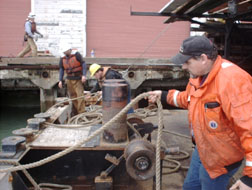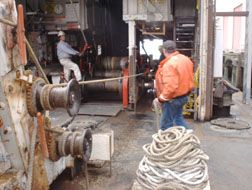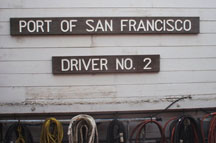The days of steam are long past…or are they? Our intrepid correspondent Guy Span, S.D., finds an example of a steam engine that still holds its own against diesel.

Published: March, 2003
Most people believe the age of steam reached its twilight years back in the 1950s, when the railroads moved to diesel locomotives. That would mean that steam power would have virtually no application in this modern century. Certainly for the Roger Rabbit characters running the Diesel Technology Forum, steam is indeed dead. In fact, there is no suitable alternative to diesel, according to the forum, as diesel contributes $85 billion to the U.S. economy and moves 94 percent of the nation's goods and materials. The prestigious Charles River Associates, who thoroughly analyzed the nation's transport, construction, and mining sectors, provided these figures. And they found a lot of diesel, just as they were paid to do.
Buried in this charming report are a number of highly apocryphal statements, such as in footnote 50, "We expect that nearly 100 percent of the off-road equipment used in construction is diesel powered." That's a footnote! And we are generally led to believe a footnote is where you find cites for information, not speculation which, as in this case, is just plain wrong.
Just for the record, steam powers a majority of electrical generating power plants, a significant number of Great Lakes freighters, the majority of the Matson Line container fleet, a high proportion of U.S. Navy ships (including nuclear vessels), and closer to hand, the Port of San Francisco's two steam-powered pile drivers.
These two steam pile drivers help maintain miles of pilings and groups of pilings (called Dolphins) around the Port of San Francisco. It's a job loaded with jargon, hand signals, and whistle signals that were developed in the days before radio, when workers needed to talk across longer distances in the presence of loud machinery. Sometimes shouting is just not practical, so alternatives were developed: stop--a closed fist; up the one line--thumb up, followed by one finger; one whistle-stop if lifting or lift if stopped.
It's not all about driving pilings. Sometimes it's removing older ones, sometimes it's working with the underwater divers to rig for a pull or place some lower supports. Sometimes it's lifting with the boom. Since the driver has no propulsion, sometimes it's using the lines to pull itself crab-like along the dock (called warping) or sending out the motorboat with lines to pull itself to an adjacent dock.
So what powers this Driver No. 2? There is a huge boiler, operating at 120 pounds per square inch, burning diesel fuel driving an old logging skid. The skid was welded to the barge it floats on in the late 1940s. The Logging Skid is even older. It's sort of a semi-self-propelled, self-contained, all-purpose workshop and tree remover. To move, it sat on steel sleds and attached a line to a stout tree and then used its steam power to winch itself forward.
The engine drives three winches, one of which counter rotates, so that the full range of options is available. In its logging function, ropes would connect to saws and it would chew up a forest, burning waste wood for fuel. In its new application, the skids have been welded to the deck and the rope winches connect to a pile driver, a slide bar (which moves side to side and can lift things off a "Gant Line"), or an optional boom, which can drive a lighter weight pile or lift, as needed.
There is a hierarchy of jobs onboard, the most senior being the Operator, or the person who runs the steam driven machinery. He takes orders (depending on the job) from either the lead man, who is in a position in the loft (up in the framework), or from someone else in a position to see the work. Assisting the Operator is the Spool Tender, who actually operates the lines, slipping them into the winch holders and out, as needed. Generally, an Operator has already worked as a Spool Tender, so the two of them work harmoniously.
The whole thing creaks and groans as if she were a sailing ship from the days of yore. But make no mistake about it, onboard this is a team of professionals who work well together. A crisis simply makes them better at it. Jim Meisenbach, the Driver Operations Supervisor, noted that on the Driver, you had to leave your animosities at the Pier Head. "There is no room for anything but teamwork here," he noted. With a main driver weight of 3,200 pounds and a Swing Lead Driver weighing 2,400 pounds, this is nothing to play around with. History suggests that these guys respect the heavy stuff they work on--with only four serious accidents since 1978, they have created an enviable safety record in any construction industry.
On this reporter's tour, it was time to move the Driver forward. There was steam up and the crew was poised around the dock and on the Driver to winch her ahead. A stern line was kept attached and a bowline was released to move her forward to the next position. After releasing the bowline, the stern line announced that it had worked enough and separated with a dry "pop." Suddenly, the unpowered Driver was floating free toward the shore, with no lines attached.
There was no consternation among the crew. They calmly picked a new line and cast it toward the dock, but the Driver had separated far enough for the line to fall short. The Driver was still moving toward the bulkhead and the separation from the dock was increasing. Jim Meisenbach went inside and grabbed a lighter weight line that he attached to the heavier line. The lighter line could be thrown across the increasing gap and pulled the heavier line in, and the crew attached it to a bollard. With less than 80 feet from a collision with the bulkhead, the crew brought the Driver under control.
Your reporter could tell by the lack of excitement among these regulars that there was never any danger. It was simply a fallback plan; that is, what one did when the first and second plans failed. Something they had seen many times before and would see again. Professionals who knew what to do.
Rickey Johnson is the operator. He has worked with the Driver for years, back in the days when the Port had its own tugboat to move Driver No. 2 from job to job. He remembers when both Drivers (No. 3 sits idle at Pier 80) had more work than they could handle. While Driver No. 2 has enough work, he notes there appears to be less as time goes on.
Rickey pointed out the logging sleds still welded onto the base of the Driver and put her age at sometime before WWII. The engine and boiler are a Dutton D-4860-3DS, designed for logging, but with a good Spool man, useful for all the work required from Driver No. 2. A brass plate points to time spent working for the U.S. Army Corps of Engineers. Rickey speculated that this is the last steam Pile Driver operating on the West Coast and perhaps in the country. It is the end of an empire, where operators know how and when to "blow down" the boiler to eliminate scale or when to add water treatment to prolong the life. The water injector on this Driver, usually a cranky device, has been set so that by only turning one lever, fresh water from the 16,000-gallon tank can be added with a minimum of fuss.
Bobby Keith, the Spool man, pointed out the "gypsies"--the gears that could be either rope powered from the main engine or ratcheted by a heavy bar. Seemingly without any effort, he handled the lines around the winch, either feeding lines to it, or taking them away. The trick is to know exactly what to do and when to do it. Years of experience made this appear effortless and simple, but to the newcomer, it was clearly none of these.
So for the rest of us, Driver No. 2 works most days, putting in or taking away pilings in plain sight, yet out of sight. It is a microcosm of industrial life, where people must rely on the expertise of their fellow workers to get through the day. The day Jim's hand got ripped by a broken line, Bobby drove him to St. Francis, commandeering a police officer along the way. When the doctors discussed amputation, a riot almost broke out as the freshly arrived crew of the Driver refused to accept this alternative. Today, Jim still has his hand and the crew has the camaraderie that can only develop after a lifetime of working with equipment that weighs in the tons.
For the crew of Driver No. 2, the art of warping along a dock is second nature; 20 piles a day is good production and popping a dried up line is just one of the many hazards.



